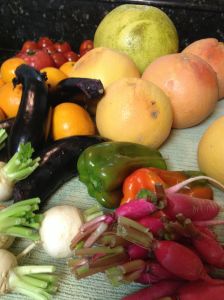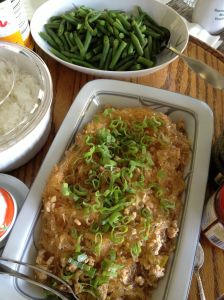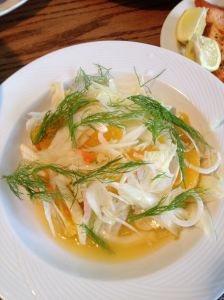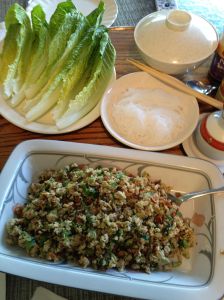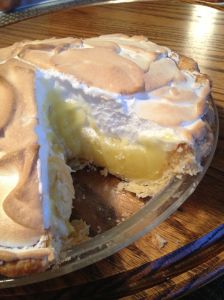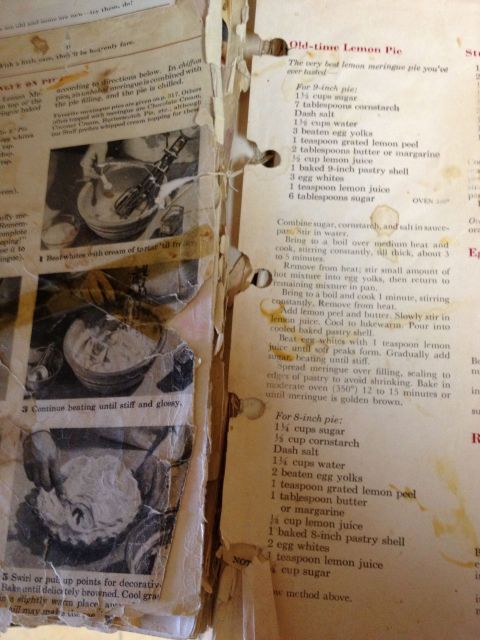slow down, detour ahead
April 29, 2013 § 6 Comments
My encounter with cancer almost two years ago changed me. An obvious statement perhaps, but I’m not talking about the remnants of treatment – scars and other body changes from surgery, the neuropathy (lack of feeling) in fingertips or toes from chemotherapy, more frequent forgetfulness and loss of words that I attribute to “chemo-brain” rather than aging, and the cloud of worry that slowly dissipates as time moves you further away from the milestone of NED (no evidence of disease), more commonly known as remission, but never known as cured. My “core” has changed too. I try to be more patient with myself and with others, more accepting and less judgmental, more joyful and less worried, forgiving and forgetting small injustices and inconveniences, appreciating life daily. As I gradually re-insert myself into the world of work, I’m less concerned with the size of the paycheck and benefit package, and more with the mission and ethics of the company I’ll keep and the amount of good we can do. And work needs to fit into the rest of my life, rather than the reverse which was how things were B.C. (before cancer).
I flew into L.A. three weeks ago for a long weekend visit with my parents. Although I had only planned to stay a few days, my dad who’s nearing 90 ended up in the hospital the day after I arrived. He came home three days later, but the cause of the loss of consciousness that sent him off in an ambulance was still a mystery. It was time to check-in online for my flight back to Denver. But wintry weather and snowy conditions prompted Southwest to offer passengers the opportunity to re-book their flights up to two weeks later and waive any fare increase. I took the detour.
That extra two weeks ends soon; I fly back this Wednesday with another forecast of Front Range snow, but probably not enough to delay travelers this time. The time, as the popular refrain goes, was well spent. Dad’s back at home and gradually getting back to his old self and routines minus driving. He, mom and the whole family are much more aware of the need for better health and wellness self-care for both of them. We three sisters made calendar commitments to visit often for fun and just to see how they’re doing (and not just take the “We’re fine!” in a phone conversation at face value). Dad had several follow-up appointments after his hospital stay, so mom and I got to meet his medical team of “regular doctor, heart doctor and kidney doctor” as he calls them. And although our family dynamics can sometimes/often be annoying, irritating and downright messy, we almost seamlessly pulled together to make things better right away and for the future. Best of all, we re-connected, shared the love and had some fun too.
I had some quiet time on my own strolling in a beautiful and funky Venice Beach neighborhood under a clear blue sky.
Venice can also be charmingly retro and just plain bizarre.
Of course I had to swing by Santa Monica and hang with the farmers market crowd. I lugged home three heavy bags of the most diverse load of produce I’ve ever bought at a farmers market. My haul represented what would normally be three seasons in Colorado and included
- Winter – tangerines, grapefruits, a pomelo (of course these don’t even grow in my state), potatoes
- Spring – mizuna, ruby streaks mustard, arugula, sugar snap peas, radishes, baby turnips, spring onions, spring garlic, strawberries
- Summer – tomatoes, eggplant, baby zucchini, bell peppers, daikon radish, green beans, fennel
Although my mom no longer prepares elaborate meals for just the two of them, she instilled in me and my sisters the love of good food, well prepared and artfully presented. Here’s a few of the dinners and dishes we enjoyed together over the past several days with that cornucopia of vegetables.
Sister and niece served a Chinese dish of bean threads and minced pork called “Ants in a Tree” with gently steamed green beans and rice one night. A salad of fennel, orange and slivered onion was a side dish for dinner on another.
Mom made soba (not pictured) and shrimp tempura, while I prepared the vegetable dishes of blanched mizuna (cut and served cold with ponzu, a light citrus soy sauce) and seared Japanese eggplant drizzled with a miso-sesame sauce. Another night minced chicken in lettuce wraps repeated the Chinese theme of “ants”, small bits of seasoned meat.
Tofu soup, radish tsukemono (quick salted pickles) and a chicken-egg-vegetable donburi (over rice) made a lovely and delicious meal. I found a frayed and well-splattered recipe in one of mom’s old cookbooks to make one of the best lemon meringue pies we’ve ever eaten!
Memories refreshed, I happily return home.
plum delicious!
August 7, 2012 § 14 Comments
Here’s last night’s dessert ~ backyard plum galette, vanilla ice cream (store bought) and plum sauce. Since our Baking with Julia recipe made a double batch of dough and I had enough plums, I went ahead and made two, and delivered the second one (still warm) to our good friends, Mo and Peter. It got a big thumbs up from everyone!
I started on this dessert in April; my hair just starting to sprout post-chemo, along with our fruit trees leafing out! I’m munching a yummy cookie from Lynn at Eat Drink Man Woman Dogs Cat, one of a box she sent me when I supported her in “The Big Climb” for leukemia/lymphoma research and support for survivors. Back to plums, doesn’t everyone grow their own? Actually, this is the first year we had enough from our backyard to do more than just taste. Colorado’s Front Range climate is not kind to fruit trees, so most of ours comes from the slightly milder Western Slope, which grows the most delicious peaches (I have not tasted the famous Georgia peach, however). And since our local abundance is stone fruit and not berries, this is what went into Flo Braker’s Berry Galette recipe.
We had to pick plums (and some small peaches) a little under ripe. By late July, the robins and squirrels have figured out there is a daily buffet of fruit in my yard. While I think there is plenty to go around, they eat or damage so much fruit, that we have to pick it under ripe and barely get our share. Luckily the plums ripened up nicely off the tree, the peaches not so much so I ended up composting those. 😦
This was a small batch of a simply made dough, so I thought it best to do by hand rather than in the food processor. The food processor is so fast, that it’s more difficult to control cutting in the butter and avoid over mixing and/or warming the small amount of ingredients. Dry ingredients, including a beautiful multicolored cornmeal went into the bowl which I mixed to blend.
Remove the ice cubes from now well-chilled water and add the yogurt or sour cream. What a great idea! I often use a little lemon juice or even vinegar to pie dough (helps keep it tender), but this adds a little richness and flavor too. Now you have to work fast, especially in the summer, to avoid letting the butter get too soft which can lead to a greasy, too soft dough and then a tough crust after baking.
I went ahead and used the whole stick of butter (what’s the point of leaving 1 tablespoon out?), quickly cut it into small pieces with the bench knife and tossed it into the flour mixture. If the weather’s warm and you don’t have air conditioning, chilling the dry mix in the refrigerator first will help.
Use a pastry cutter, a pair of table knives or your fingers (only if they’re cool enough though), cut and toss the butter pieces until the largest pieces are pea-sized. Add the chilled liquid, and gently toss and mix to evenly distribute the moisture. Keep a little iced water on hand if you need a little more just to moisten most of the dry mix; you don’t want a too wet dough which tends towards a tough cracker-like crust (remember, water + mixing = gluten).
My dough was a little dry (better than too wet), so I just pressed and folded it on itself a couple of times to bring it together; again you don’t want to overwork here either. The hour or so rest in the refrigerator allows the moisture to distribute more evenly, re-chill the butter and relax the gluten; all of this will make rolling a lot easier. See the butter bits and the colorful flecks of the cornmeal?
I prepped the plums while the dough chilled. These plums were easy to split and pit with my fingers (a lot faster than with a paring knife) and they were small enough to leave halved. I tossed them with the sugar, and then drained, hoping they would give up some of their juice before baking.
If you roll out two portions of dough, place them on a chilled parchment-lined sheet pan. Put the first one back in the refrigerator if your kitchen is warm, or it’s taking a long time to roll out the dough. The oven should be hot by now, and let any calls go to voicemail. Place the fruit onto the dough leaving a 2″ border, gently fold up and pleat; pressing the edge slightly at the bottom of each pleat helps keep the galette from opening during baking.
I did not glaze or sugar the crust before baking, but the small amount of sugar in the dough gave the crust a nice golden brown color after a full 40 minutes at 400°F. Wow, those were juicy plums! After a short 5 minutes of cooling, I c-a-r-e-f-u-l-l-y moved them using two pancake turners directly to platters; I didn’t want to serve galettes-with-parchment later. That sticky goo was a bit tricky to recover from the parchment and pan, but it made a yummy sauce!
Oh, and I drizzled the honey over the fruit after baking, instead of before. The tart plums definitely needed more sweetness, but I wanted to avoid more oven goo.
Here’s my breakfast next morning, and here’s the squirrel’s. That red plum was gone by the time I got this posted.
a new April Fool’s Day tradition
April 1, 2012 § 2 Comments

VERY LOCAL OMELET (3-mile eggs, Mark’s chèvre, Jay Hill Farm’s chard and spring onions, garden chives and parsley, Mo’s bacon) served with my Hot Cross buns and a Virgin Mary
Looking at this bright sunny photo, you might think we moved back to southern California. Nope, fooled ya! We’re still in Boulder, but it feels like the weather has moved here from SoCal. March set a record for high temperatures and low snowfall (almost nothing in the month that we expect to get most of our snow on the Front Range). I spent a good deal of time out in the garden, a few days in shorts, when normally my activities would be indoors and include trying to stay warm and dry. I can’t complain about getting a break from winter without having to travel, but I’m actually looking forward to getting some rain soon.
I did squeeze in a little of my own baking between challenge baking and gardening tasks…
Our “house” sourdough with mixed grain flours, apple pie and orange currant emmer scones (I froze some for later so we didn’t gain 5 pounds apiece).
And some cooking with Phil manning the grill (yup, it’s been warm)…
Grilled garlic-rosemary lamb and potatoes, shrimp risotto with peas and red pepper (locally frozen), and “Steak-for-Phil Night” with Hana patiently waiting for something yummy to hit the deck.
Finally, I did bake the Hot Cross buns for Mellow Bakers’ first Hamelman Bread challenge yesterday. His recipe used a unusually liquid sponge to get the dough started. It’s a somewhat rich sweet dough made from milk (no water), and included a couple ounces of butter, an egg, freshly ground allspice (I really liked that addition), and a pretty hefty load of currants, plus traditionally, candied lemon or orange peel which I didn’t have or make. I simply substituted the zest of a lemon which gave a nice fragrance without more sweetness, although I will plan ahead and candy some peel next time. The mixing technique was interesting because you combined all of the final dough ingredients including the butter and egg, before you added any liquid which was all in the sponge. I wasn’t sure what to expect as far as gluten development from adding ingredients in this order, and it took several minutes for the dough to finally grab the dough hook so it could be effectively kneaded in the mixer. It was a little on the dry side after I added the currants (they had probably been in the cupboard a little too long), so I finished kneading those in by hand. My temperatures were a little cool, so I allowed some extra time for both the bulk fermentation and proofing the buns, and I skipped the light fold since my dough was on the firm side and had plenty of gluten strength.
My sister who does live in southern California just started to teach herself how to make bread by hand (instead of in the bread machine which she’s done for years). I got her both of the Mellow Bakers challenge bread books for her birthday and to encourage her baking (hopefully I haven’t scared her off). I’m sure we’ll both have occasions to appreciate the “mellow approach” when we get busy with other things. Oh, so why I mention this, is that my copy of Bread had a different crossing paste recipe than hers. The ingredients were just flour, oil and water – ick! She gave me the recipe in the updated edition which uses butter, milk, vanilla, sugar, lemon peel and flour (I skipped the egg because I reduced the recipe x 1/4) – yum! All in all, I was pleased with how these turned out. The aroma and flavor from the allspice had a good intensity, the texture was pleasantly chewy from the firm dough, and although some of the currants popped out when I portioned and shaped the buns, I liked the generous measure. The last two buns were even good day old with brunch this morning.
The sponge just after mixing and after proofing for about 40 minutes.
Final dough with all ingredients except for liquid; after adding and mixing in sponge.
After several minutes on low speed the dough finally grabs the dough hook but is still rough; add currants/raisins and lemon zest (in place of candied peel) towards the end of kneading.
Beginning and end of bulk rise (1 1/2 hours in my cool kitchen).
Portion slightly larger than 2 oz. and shape into buns; cover to proof another 1 1/2 hours.
Updated sweet crossing paste ready to pipe.
Pipe in one direction first, then turn pan to finish the crosses; paste holds a nice string for a neat cross pattern. You can see Hana’s forefeet peeking out from under the rotated pan. She’s hoping I’ll drip some paste on the floor for her to taste.
The buns brown very quickly but keep them in the oven for the minimum time to ensure doneness. These have just been brushed with the simple syrup for a sweet shiny (and sticky) finish.
First bites show a nice crumb and generous fruit. I substituted 2 oz. of the white flour with whole wheat and could increase to 25% with a slight increase of milk for the extra absorption of moisture from the bran. I’ll probably make these again next weekend for Easter Sunday.
My sister’s Hot Cross buns. Nice pic sis!
rolling in dough
February 24, 2012 § 5 Comments
$$$ Well, I wish!
Actually this is what we’re talking about.
Rolling a tart, pie or cookie dough to an even 1/8-inch thickness can be an intimidating task, but one that bakers need to become comfortable with. Here are the guidelines I give pastry students to help them roll doughs with more confidence. Of course, there’s no substitute for practice, practice and more practice!
- Allow enough time to chill and rest the dough thoroughly after you make it. This firms up the butter, so the dough won’t be too soft or sticky. It also relaxes the gluten, which can cause the dough to shrink back while you’re rolling it out.
- If the dough is too hard when chilled, either give it several minutes to warm back up slightly, or use your rolling pin to press or gently pound it to make it pliable while still cold. Doughs can become too breakable or sticky once you’ve rolled them thin, so its best to roll them out as cold as possible, but without being brittle and crumbly.
- Get all your tools, dusting flour, pans (already prepared with parchment or greased) out before starting.
- Try to evenly dust the surface with flour. I put a little flour into my hand, close my fist loosely and scatter the flour out between my fingers with short, quick tossing movements. Cover a little extra surface so you can quickly drag or invert the dough into more flour if needed to prevent sticking. Working quickly and efficiently is important when rolling out buttery doughs!
- Put a little flour in your hand and run it over the rolling pin to coat it lightly with the flour. Repeat this as needed if you notice the dough starting to stick to the pin.
- Try to roll with even pressure of your hands on the ends of the pin and in a direction straight away from your body. Don’t roll off the edge of the dough (it gets too thin). That edge will get rolled as you rotate the dough around. If you want a circle, give the dough a slight turn of 45° or less, roll again away from your body. Keep repeating this, turning the dough over occasionally and dragging it through more flour if it starts to stick; use the bench scraper to free it if it does. It should only take you a couple of minutes to roll the dough out to the desired size. Check to make sure it’s large enough for your pan by placing the pan on top of the dough and eyeballing to see if there’s enough to go up the sides.
- Use your pastry brush to remove excess flour from both surfaces of the rolled out dough (yes, you will have to flip it over). I find it’s better to use a little extra flour to prevent any sticking, rather than fighting with the dough because you’re only using a little flour. Quickly move the rolled dough into the pan, center it and finish shaping it to fit. If at any time the dough becomes too soft or sticky, move it onto a parchment-lined sheet pan and place in the freezer or refrigerator for a quick chill until it’s firm enough to handle again.
- If you’re making something like cinnamon rolls (or spiral rugelach) you’ll want a rectangle. Simple rotate the dough 90° when you turn or invert it while rolling until you have the desired shape and size. If you’re going to fill and roll up the dough, you only need to brush off the flour on one side, as you can brush off the other side as you roll up the dough around the filling.
- Here are some pictures using the chocolate sweet dough so you can see the flour before and after using the pastry brush on both sides. I worked quickly enough that the dough stayed together fine, even when rolled to less than 1/8-inch and flipped over.
I cut and baked 2″ cookies out of the dough. They reminded me of those chocolate wafers I can’t find at the grocery store anymore. I could use these instead for a chocolate cookie pie or cheesecake crust.







